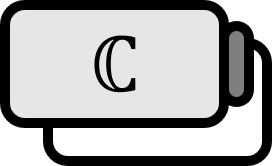接近関数の広義積分
ビルドアップ 1
多価関数を積分する際の最大の問題点は、経路が分岐線に遭遇すると関数の値が意図しない形で変わってしまうことだ。このような関数を積分する際には、これまでと同様、経路自体が分岐線を避けるようなトリックを使う。

代表的な多価関数であるログ $\log$ を考えると、負の実数軸が分岐線で原点が分岐点なので、上記のような経路を考えることができる。すると $$ R \to \infty \\ r \to 0 $$ であり、$L_{1}$ および $L_{2}$ が負の実数軸に近づくと、複素平面全体で留数定理を使用できるようになる。一見すると本当にそうなるのかと思うほど強力なアイディアであるため、これまでに学んだ全ての方法が総動員される。
例 1
例として、$\displaystyle \int_{0}^{ \infty } {{\text{Log} x} \over {x^2 + a^2}} dx$ の値を求めてみよう。
解答
下の図のように、積分経路 $\mathscr{C}$ を設定しよう。

すると、被積分関数 $\displaystyle f(z) := {{\log z } \over {z^2 + a^2}}$ に対して、 $$ \int_{\mathscr{C}} f(z) dz = {\color{red} \int_{\Gamma} f(z) dz } + \int_{L_{0}} f(z) dz + \color{blue} { \int_{\gamma} f(z) dz } + \int_{r}^{R} f(x) dx $$ $L_{0}$ を $z = \rho e^{ i \theta }$ に置換すると、 $$ \int_{\mathscr{C}} f(z) dz = \int_{ R }^{r} { {(\text{Log} \rho + i \theta ) e^{i \theta } } \over {\rho^2 e^{2 i \theta } +a^2} } d \rho + {\color{red} \int_{\Gamma} f(z) dz } + \color{blue} { \int_{\gamma} f(z) dz } + \int_{r}^{R} {{\text{Log} x } \over {x^2 + a^2}} dx $$ 今、$\theta$ が $\pi$ に近づくにつれて、$L_{0}$ が負の実数軸に近づくため、$\theta \to \pi$ を適用すると、 $$ \int_{\mathscr{C}} f(z) dz = \int_{ R }^{r} { { -( \text{Log} \rho + i \pi ) } \over {\rho^2 +a^2} } d \rho + {\color{red} \int_{\Gamma} f(z) dz } + \color{blue} { \int_{\gamma} f(z) dz } + \int_{r}^{R} {{\text{Log} x } \over {x^2 + a^2}} dx $$
発散する半円上の複素積分経路:関数 $f$ が半径 $R$ で中心が $0$ の半円 $ \Gamma $ 上で連続であり、$\displaystyle \lim_{z \to \infty } z f(z) = 0$ であれば、 $$\lim_{R \to \infty} \int_{\Gamma} f(z) dz = 0$$
一方で、 $$ \lim_{z \to \infty} z f(z) = \lim_{z \to 0} {{1} \over {z}} f(1/z) = \lim_{z \to 0} {{- \text{Log} z } \over { 1/z + a^2 z }} = \lim_{z \to 0} {{ - z } \over {a^2 z^2 -1 }} = 0 $$ したがって、 $$ \lim_{R \to \infty} {\color{red} \int_{\Gamma} f(z) dz } = 0 $$
収縮する半円上の複素積分経路:関数 $f$ が半径 $r$ で中心が $0$ の半円 $ \gamma $ 上で連続であり、$\displaystyle \lim_{z \to 0 } z f(z) = 0$ であれば、 $$\lim_{r \to 0} \int_{\gamma} f(z) dz = 0$$
そして、 $$ \lim_{z \to 0} z f(z) = \lim_{z \to 0} {{ \text{Log} z } \over { z + a^2 / z }} = \lim_{z \to 0} {{ 1 / z } \over { 1 - a^2 / z^2 }} = 0 $$ したがって、
$$ \lim_{r \to 0 } \color{blue} { \int_{\gamma} f(z) dz } = 0 $$ 従って、$r \to 0$ と $R \to \infty$ を取ると、 $$ \begin{align*} \int_{\mathscr{C}} f(z) dz =& \int_{ \infty }^{0} { { -( \text{Log} \rho + i \pi ) } \over {\rho^2 +a^2} } d \rho + \int_{0}^{\infty} {{\text{Log} x } \over {x^2 + a^2}} dx \\ =& \int_{ 0}^{ \infty } { { \text{Log} \rho } \over {\rho^2 +a^2} } d \rho + \int_{ 0}^{ \infty } { { i \pi } \over {\rho^2 +a^2} } d \rho + \int_{0}^{\infty} {{\text{Log} x } \over {x^2 + a^2}} dx \\ =& 2 \int_{0}^{\infty} {{\text{Log} x } \over {x^2 + a^2}} dx + i \int_{ 0}^{ \infty } { { \pi } \over {\rho^2 +a^2} } d \rho \end{align*} $$
留数定理:解析的な関数 $f: A \subset \mathbb{C} \to \mathbb{C}$ が単純閉経路 $\mathscr{C}$ の内部に有限個の特異点 $z_{1} , z_{2} , \cdots , z_{m}$ を持つとする。それならば、 $$\int_{\mathscr{C}} f(z) dz = 2 \pi i \sum_{k=1}^{m} \text{Res}_{z_{k}} f(z)$$
留数定理により、 $$ \int_{\mathscr{C}} f(z) dz = 2 \pi i \text{Res}_{a i} f(z) = 2 \pi i {{\text{Log} a i } \over {2 a i}} = \pi {{\text{Log} a + i {{\pi} \over {2}} } \over {a}} = {{ \pi \text{Log} a } \over {a}} + { i {{\pi^2} \over {2a} }} $$ 整理すると、 $$ 2 \int_{0}^{\infty} {{\text{Log} x } \over {x^2 + a^2}} dx + i \int_{ 0}^{ \infty } { { \pi } \over {\rho^2 +a^2} } d \rho = {{ \pi \text{Log} a } \over {a}} + { i {{\pi^2} \over {2a} }} $$ 上の等式から実部だけを取ると、 $$ \int_{0}^{\infty} {{\text{Log} x } \over {x^2 + a^2}} dx = {{ \pi \text{Log} a } \over {2a}} $$
